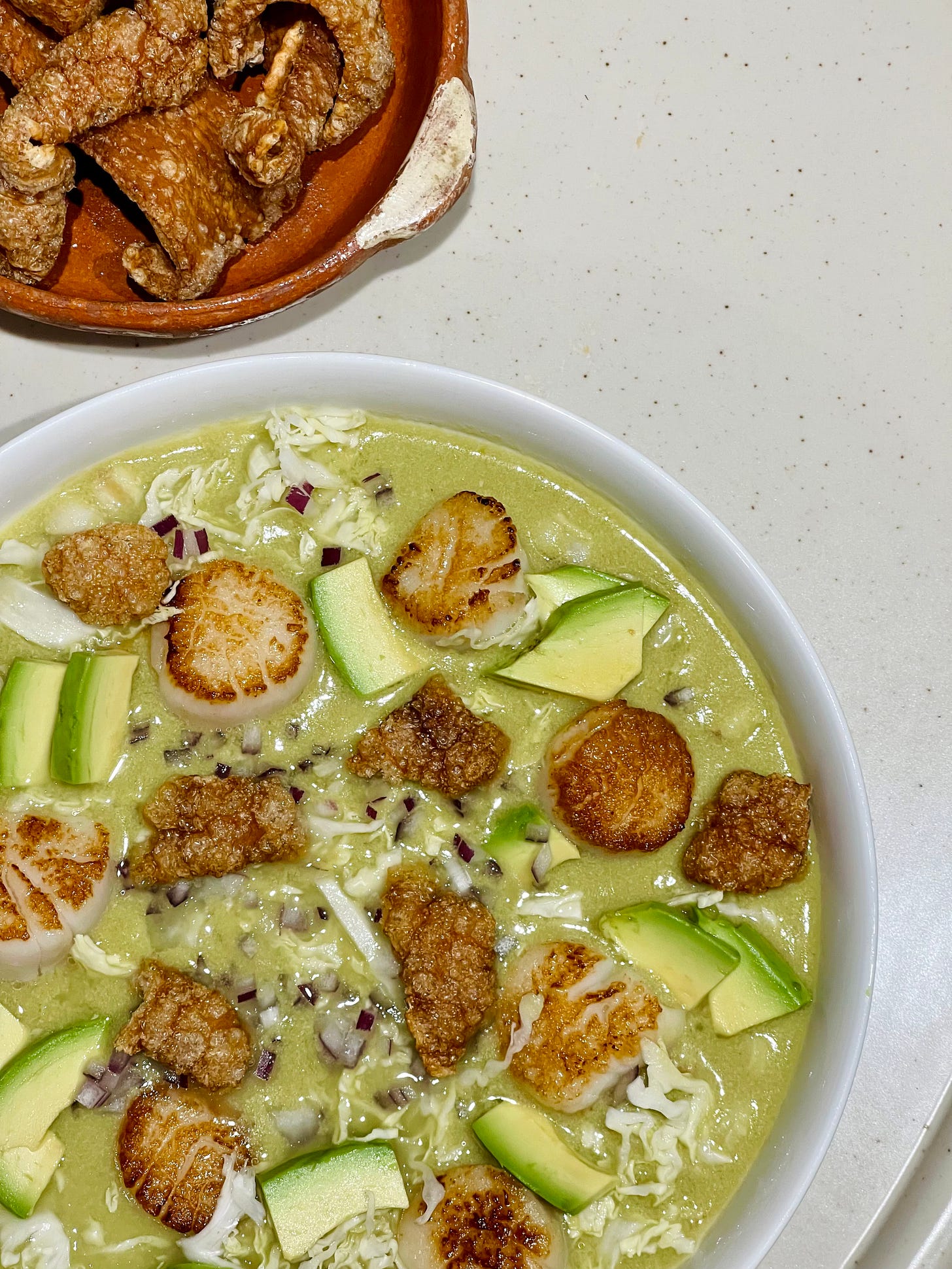Pozole Verde with Scallops and Chicharrón
Seared scallops in pozole verde is not just lux, its buttery and sweet texture stands out against crispy chicharrón
Pozole has to be the true expression of “soup weather.” It is so generous in its iterations: a pozole blanco made for purists seeking out a rich pork bone broth made with espinazo (pork neck) and served with crushed oregano; a pozole rojo from my home state of Jalisco with its bright heat from dried chiles like árbol from Yahualica and guajillo. The pozole Mixteco from Oaxaca in which a mole made with pasilla, mulato, costeño chiles, and plantains (and a few other ingredients) is added to the pork bone broth making it a beautiful mole-pozole hybrid.
But then there is Pozole verde, which hails from the state of Guerrero located on Mexico's Pacific coast. Traditionally, it is a pozole with stewed pork topped with chunks of chicharrón that is seasoned with an herby and spicy salsa verde. The first time I had a rendition of this pozole was during my college years in Guadalajara at a legendary restaurant called “RUTE El Castillo del Pozole” where an awning at the entrance is shaped like a castle as the pozolería of your dreams would.
I was just in Guadalajara last week and it never fails that I get super melancholic wondering what my life would’ve been if I never would’ve left and immigrated to the U.S. What I know is that there would’ve been many more pozoles in my life, like the pozole I grew up eating in Vallarta: my mom’s pozole rojo con champiñones. Or the kind you eat when you feast, topped with chicharrón and served with tacos dorados de requesón on the side. So I make pozole, as close as I can to those memories.
Maíz pozolero (hominy) is the most important component of pozole in the way maíz is to Mexican cooking. Cooking your own hominy absolutely requires planning ahead, but it is so worth it. In a nutshell, you can start with whole-grain dried corn that is nixtamalized with cal and then cooked for pozole. I have a guide to doing just that on Food & Wine. But if it seems daunting for a weeknight dinner (because it is!), try to get your hands on some of Rancho Gordo’s Prepared Hominy Posole, which has already been nixtamalized to remove the pericarp aka the outer skin, making it more nutritious, and turning the flavor of corn super floral.
Preparing it is as easy as soaking nixtamalized dried corn like Rancho Gordo’s Prepared Hominy in water for six hours or overnight. Drain and add hominy to a large pot along with enough fresh water to cover by two inches, add half an onion, and simmer for two hours, covered with a tight-fitting lid. You will be rewarded with chewy-like-mochi hominy that blooms like popcorn as it finishes cooking in your pozole. Reserve two cups of the cooking liquid and use it in place of water in the recipe for an extra punch of corny flavor.
But I know that reaching for cooked hominy that is ready to go can be the difference between cooking pozole at home and not, and home-cooked pozole is what we are after. Before you grab a can of hominy, my tip is to look first for cooked “maíz pozolero” (hominy) in the refrigerated section of your Mexican market. It is usually sold by the pound in plastic bags next to the fresh masa at Mexican grocers. If you’re in Southern California, Northgate Gonzalez has it on the daily, and it is by far superior to canned. In Mexico, most home cooks buy cooked hominy that is vacuum-sealed into one-kilo bricks from the neighborhood tiendita or mercado. It really is the best shortcut to cooking your own. If you go with canned, make sure to rinse it very well and try your best to not cook it to death.
I say this after cooking two separate batches of this pozole recipe to tell you that you will be rewarded if you cook, or source freshly cooked hominy for your pozole. You’ll see that the canned hominy at the top has almost no white in the middle of the cross-section cut (top right). The white in the middle that is distinctive in freshly cooked hominy (bottom right) is part of the germ and the endosperm in corn that gives hominy a chewy texture. When you finish cooking it in the pozole broth, the hominy (bottom left) blooms like popcorn, whereas the canned hominy (top left) starts to fall apart and get mushy.
The first time I made a version of this pozole I made it with shrimp, but I’m a sucker for a hard sear on a scallop. The natural sweetness of scallops and the texture of the golden crust stand out to the chicharrón in the most graceful way, giving you the most incredible mouthfeel. I’d go as far as saying that you don’t even need tostadas or limes (fighting words!).






